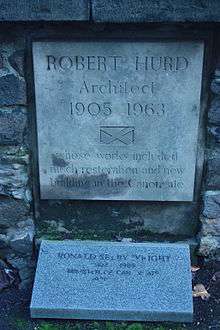Robert Hurd

Robert Philip Andrew Hurd (29 July 1905 – 17 September 1963) was an influential conservation architect. His original aim was to be an architectural author specialising in traditional forms. He came to Scotland in 1930 and worked in the Edinburgh College of Art with Frank Mears. He is noteworthy as an early and highly respected conservation architect.
Life
Hurd suffered from polio in early life and walked his whole life with a limp. The son of Sir Percy Angler Hurd MP and Hannah Swan Cox he was educated at Marlborough College and then the LCC Central School of Arts. Thereafter he studied at Emmanuel College, Cambridge becoming a close friend of Raymond McGrath and Mansfield Forbes. He came to Scotland in 1930 and completed his architectural studies at Edinburgh College of Art. It is known that as a student he lived in a house at 49 George Square.
He was an early member of the National Trust for Scotland and author of one of its first major publications “Scotland Under Trust” (1938). In the same year he began campaigning to save historic buildings, his first coup being to temporarily rescue Tailors Hall on the Cowgate from demolition. As an ironic twist Hurd was declared unfit for overseas service but was an officer in the Royal Engineers (1940–46) and was put in charge of removing Edinburgh’s cast-iron railings for the war effort. During this time he also became president of the Saltire Society a role he continued until 1948.
Work

In 1932 he went into partnership with Norman Neil (b.1899) who was deeply influenced by German and Scandinavian architecture. Hurd himself quickly developed a love of conservation but also displayed a love of the modern in several projects.
As a very early project he restored Lambs House in Leith in 1937.[1] In 1952 he received a major commission to replan and rebuild Edinburgh’s Canongate, largely demolishing buildings and setting back the rebuilt facades to a new wider and straighter building line. Less care was taken over the rear elevations. The scale of the work required him to take on Ian Begg as a junior partner in 1953. He campaigned against the loss of George Square and in 1959 he was commissioned to restore the west side for University use. He was strongly interested in the arts and also helped found the Scottish Georgian Society, was an advisor to the BBC in Scotland, and helped to set up the Edinburgh Festival. He has only one noteworthy building of contemporary rather than historic idiom, at Ravelston Gardens.
Also an outsider in other senses Hurd never joined the RIBA. Hurd was gay and had a single lifelong partner from around 1935.
Hurd died whilst on holiday in Switzerland but in honour of his work his body was flown home. In honour of his contribution to the area he was the last full interment within the otherwise closed-to-burial Canongate Kirkyard.
Principal Works
- Ravelston Gardens (modernist flats), Edinburgh (1935)
- Restoration of Acheson House, Canongate, Edinburgh (1936)
- Restoration of Hamilton House, East Lothian (1937)
- Restoration of Lamb’s House in Leith (1937)
- Restoration of Loudoun Hall near Ayr (1939)
- Restoration of Culzean Castle (1946-8)
- Restoration of tenements on Bank Street, Edinburgh (1950)
- Rebuilding of Chessel’s Court and Morocco Land, Canongate Edinburgh (1952)
- Rebuilding of numerous tenements on Canongate Edinburgh (1952-5)
- Restoration of Culross Abbey House (1954)
- Restoration of Bible Land and Shoemaker Land, Canongate Edinburgh (1956)
- Library and Village Centre, Skelmorlie (1956)
- Extensions to his Alma Mater Emmanuel College, Cambridge (1957) (criticised by the Anti Ugly action group in 1959)
- Further restoration at Chessel’s Court (1958)
References
- ↑ Dictionary of Scottish Architects
- Dictionary of Scottish Architects: Robert Hurd